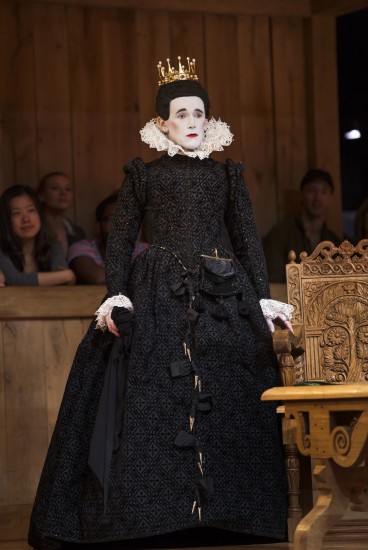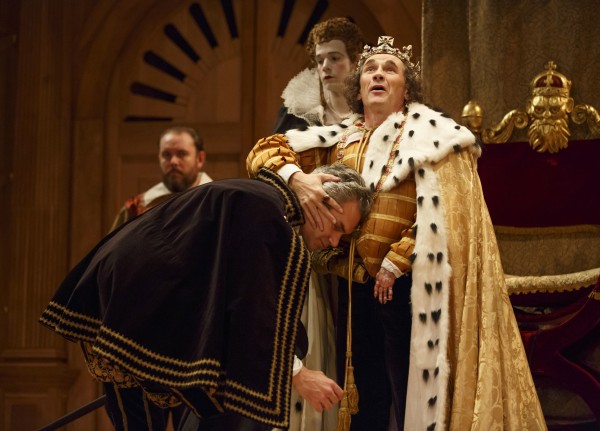
Mark Rylance is simply spectacular as Olivia in old-fashioned version of TWELFTH NIGHT on Broadway (photo © Joan Marcus)
MR. WILLIAM SHAKESPEARES TWELFE NIGHT, OR WHAT YOU WILL /
THE TRAGEDIE OF KING RICHARD THE THIRD
Belasco Theatre
111 West 44th St. between Sixth & Seventh Aves.
Tuesday – Sunday through February 16, $25 – $165
www.shakespearesglobe.com
Shakespeare’s Globe makes its Broadway debut by turning back the clock some four hundred years with stellar versions of Twelfe Night, or What You Will and The Tragedie of King Richard the Third. Running in repertory at the Belasco through February 16, the productions hearken back to the Bard’s time, featuring onstage candlelight, hand-stitched costumes made out of authentic materials, such period instruments as the rauschpfeife, the sackbut, the cittern, and the theorbo, and men playing all the roles, highlighted by a pair of spectacular performances by two-time Tony winner Mark Rylance (Boeing-Boeing, Jerusalem). Rylance is a riot as Olivia in the mistaken-identity comedy Twelfth Night, wearing a dazzlingly detailed full-length gown that makes it look as though the character is gliding across the floor like a true noblewoman, rather than doing anything as common or manly as merely walking. Near the beginning of a seven-year mourning period for her father and brother, the Countess Olivia is being courted by Duke Orsino (Liam Brennan) and Sir Toby Belch (Colin Hurley) while developing the hots for Cesario (Samuel Barnett), who is in the service of Orsino — but the youth Cesario is actually the shipwrecked Viola in disguise, twin sister of Sebastian (Joseph Timms), who survived the disaster as well, although each sibling believes the other to be dead. In the meantime, Olivia’s gentlewoman, Maria (the deliciously wonderful Paul Chahidi, baring impressive cleavage), has conspired with Sir Toby, Sir Andrew Aguecheek (Angus Wright), and servant Fabian (Jethro Skinner) to dupe Olivia’s loyal and dedicated steward, Malvolio (the wickedly funny Stephen Fry), into thinking that Olivia is in love with him, leading to lots of mayhem and surprise discoveries. But at the center of it all is Rylance, whose every movement is a joy to behold. Director Tim Carroll keeps it all light and lively on a relatively sparse stage backed by an oak screen with two-level stalls on either side where members of the audience can sit — and even become part of the show.

Mark Rylance has a blast as the conniving Duke of Gloucester in seriocomic RICHARD III (photo © Joan Marcus)
Rylance is playfully malevolent as the Duke of Gloucester in Richard III, although it’s all just a bit too lighthearted for Shakespeare’s dark tale of a power-hungry deformed creature murdering friends and family on his way to the throne. With a stiff left hand hanging lifeless against his body, the ultra-paranoid Richard woos the freshly widowed Lady Anne (Timms), whose husband he killed; betrays his brothers Clarence (Brennan) and Edward (Colin Hurley); disparages Queen Elizabeth (Barnett); falsely accuses Lord Hastings (Chahidi) of treason; and orchestrates other lies and deception as the crown dangles within his grasp during the winter of his discontent. Rylance has a ball uttering devilishly humorous asides and offering a white rose to an audience member in the multilevel stage seating, repeating a charming laugh that belies his deviousness. The supporting cast, consisting of many of the same actors appearing in Twelfth Night — including lone American Matt Harrington playing multiple small roles in each work — is outstanding in both productions, playing their parts, whether male or female, with a robust gusto. Among the other stars are Claire van Kampen’s score and Jenny Tiramani’s sleek stage design and period-specific costumes, which the audience can watch being put on the actors by their expert dressers, starting about twenty minutes before curtain time. If you have a choice, the marvelously inventive Twelfth Night is the one to see, but if you can manage it, you should try to see both, preferably as close together as possible.